
Medicago is a genus of flowering plants, commonly known as medick or burclover, in the legume family (Fabaceae). It contains at least 87 species and is distributed mainly around the Mediterranean Basin, and extending across temperate Eurasia and sub-Saharan Africa. The best-known member of the genus is alfalfa, an important forage crop, and the genus name is based on the Latin name for that plant, medica, from Greek: μηδική (πόα) Median (grass). Most members of the genus are low, creeping herbs, resembling clover, but with burs. However, alfalfa grows to a height of 1 meter, and tree medick is a shrub. Members of the genus are known to produce bioactive compounds such as medicarpin and medicagenic acid. Chromosome numbers in Medicago range from 2n = 14 to 48.

Medicago truncatula, the barrelclover, strong-spined medick, barrel medic, or barrel medick, is a small annual legume native to the Mediterranean region that is used in genomic research. It is a low-growing, clover-like plant 10–60 centimetres (3.9–23.6 in) tall with trifoliate leaves. Each leaflet is rounded, 1–2 centimetres (0.39–0.79 in) long, often with a dark spot in the center. The flowers are yellow, produced singly or in a small inflorescence of two to five together; the fruit is a small, spiny pod.
NVC community CG7 is one of the calcicolous grassland communities in the British National Vegetation Classification system. It is one of three short-sward communities associated with heavy grazing, within the lowland calcicolous grassland group, and is regarded as the eastern counterpart of "typical" chalk grassland.

Medicago lupulina, commonly known as black medick, nonesuch, or hop clover, is a plant of dry grassland belonging to the legume or clover family. Plants of the genus Medicago, or bur clovers, are closely related to the true clovers (Trifolium) and sweet clover (Melilotus). Like the true clovers, black medick has three leaflets and a small, yellow flower closely resembling those of lesser trefoil. Black medick belongs to the same genus as alfalfa.
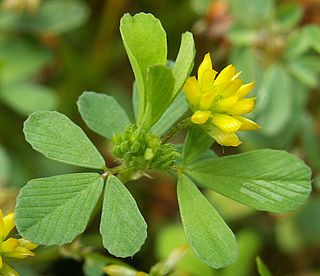
Trifolium dubium, the lesser trefoil, suckling clover, little hop clover or lesser hop trefoil, is a flowering plant in the pea and clover family Fabaceae. This species is generally accepted as the primary plant to represent the traditional Irish shamrock.

Medicago polymorpha is a plant species of the genus Medicago. It is native to the Mediterranean basin but is found throughout the world. It forms a symbiotic relationship with the bacterium Sinorhizobium medicae, which is capable of nitrogen fixation. Common names include California burclover, toothed bur clover, toothed medick and burr medic.
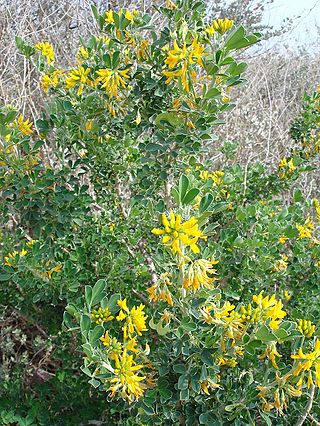
Medicago arborea is a flowering plant species in the pea and bean family Fabaceae. Common names include moon trefoil, shrub medick, alfalfa arborea, and tree medick. It is native to several Mediterranean Basin countries – Spain and the Balearic Islands, Italy including and Sardinia and Sicily, Greece including Crete and the East Aegean Islands, and Turkey. It primarily grows on rocky shores among shrubby vegetation. It forms a symbiotic relationship with the bacterium Sinorhizobium meliloti, which is capable of nitrogen fixation. It is the only member of the genus Medicago which is used as an ornamental. M. arborea is sometimes misidentified as Cytisus, which it resembles.
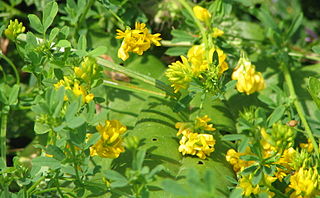
Medicago falcata is a plant species of the genus Medicago. It is native to much of Europe and Asia, but is found throughout the world. It forms a symbiotic relationship with the bacterium Sinorhizobium meliloti, which is capable of nitrogen fixation. Its common names include yellow lucerne, sickle alfalfa, yellow-flowered alfalfa, yellow alfalfa, sickle medick and yellow medick.
Medicago intertexta, the hedgehog medick, Calvary clover, or Calvary medick, is a flowering plant of the family Fabaceae. It is found primarily in the western Mediterranean basin. It forms a symbiotic relationship with the bacterium Sinorhizobium medicae, which is capable of nitrogen fixation.
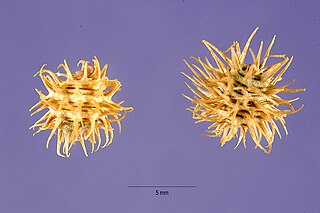
Medicago laciniata is a plant species of the genus Medicago. It is found primarily in the southern Mediterranean basin. It forms a symbiotic relationship with the bacterium Sinorhizobium meliloti, which is capable of nitrogen fixation. Common names include cutleaf medick and tattered medick. Grows in Sinai, Egypt.

Medicago littoralis is an annual plant species of the genus Medicago. Its native range encompasses the Mediterranean Basin, from Macaronesia to the Caucasus; it has been introduced elsewhere. It is useful as a forage for livestock. As a leguminous plant, it is capable of adding nitrogen to soils, through its symbiotic relationship with the bacterium Sinorhizobium meliloti, which enables nitrogen fixation. Common names include shore medick, water medick, coastal medick, and strand medick.

Medicago marina is a plant species of the genus Medicago. It is native to the Mediterranean basin but is found worldwide. It forms a symbiotic relationship with the bacterium Sinorhizobium meliloti, which is capable of nitrogen fixation. Common names include coastal medick and sea medick.
Medicago murex, the spiny medick, is a plant species of the genus Medicago. It is found throughout the Mediterranean basin. It forms a symbiotic relationship with the bacterium Sinorhizobium medicae, which is capable of nitrogen fixation.

Medicago orbicularis is a plant species found throughout the Mediterranean basin and along the European Black Sea coast. It forms a symbiotic relationship with the bacterium Sinorhizobium medicae, which is capable of nitrogen fixation. Common names include blackdisk medick, button clover, button medick, and round-fruited medick.
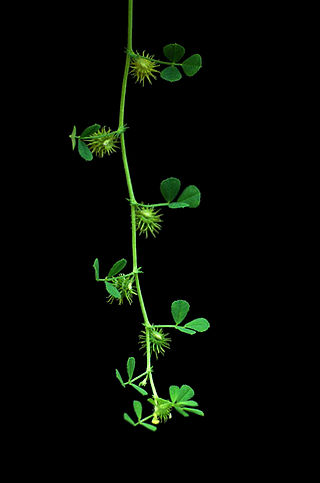
Medicago praecox, the Mediterranean medick or early medick, is a plant species of the genus Medicago. It is found throughout the northern Mediterranean. It forms a symbiotic relationship with the bacterium Sinorhizobium meliloti, which is capable of nitrogen fixation.

Medicago scutellata is a plant species of the genus Medicago. It is found throughout the Mediterranean basin. It forms a symbiotic relationship with the bacterium Sinorhizobium meliloti, which is capable of nitrogen fixation. Common names include snail medick and shield medick.
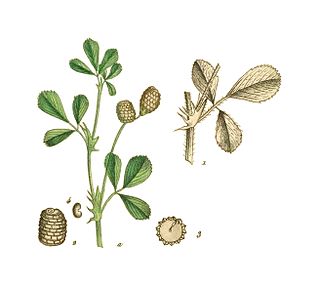
Medicago turbinata, the Southern medick, is a plant species of the genus Medicago It is found throughout the Mediterranean basin. It forms a symbiotic relationship with the bacterium Sinorhizobium medicae, which is capable of nitrogen fixation. An unidentified lectin isolated from M. turbinata has shown limited usefulness as a phytohaemagglutinin. The seed weight is 4.66 pounds.
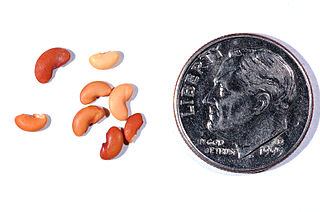
Medicago doliata is a species of annual herb in the family Fabaceae. They have a self-supporting growth form and compound, broad leaves.

Medicago monspeliaca, the hairy medick, is a species of annual herb in the family Fabaceae. They have a self-supporting growth form and compound, broad leaves. Individuals can grow to 0.12 m.
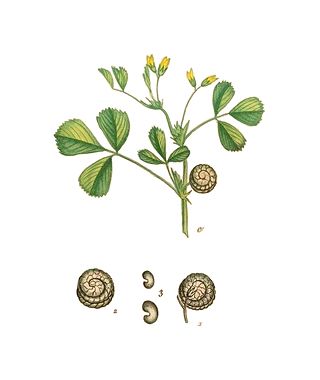
Medicago rugosa, the wrinkled medick, is a species of annual herb in the family Fabaceae. They have a self-supporting growth form and compound, broad leaves. Individuals can grow to 0.2 m.
















